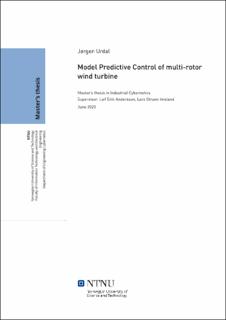| dc.contributor.advisor | Andersson, Leif Erik | |
| dc.contributor.advisor | Imsland, Lars Struen | |
| dc.contributor.author | Urdal, Jørgen | |
| dc.date.accessioned | 2021-09-23T18:10:18Z | |
| dc.date.available | 2021-09-23T18:10:18Z | |
| dc.date.issued | 2020 | |
| dc.identifier | no.ntnu:inspera:56990118:38065577 | |
| dc.identifier.uri | https://hdl.handle.net/11250/2780942 | |
| dc.description.abstract | Skalering av konvensjonelle vindturbiner for å imøtekomme det økende kraftbehovet kommer med en rekke utfordringer. Ved å skalere vindturbiner øker effekten med kvadratet, mens vekten øker med kuben til rotorradiusen. Et alternativ til den konvensjonelle enkeltrotor-vindturbinen er multirotor-vindturbinen, der man kombinerer flere rotorer på en enkelt struktur.
Vestas har laget en multi-rotor vindturbin kontroll-utfordring som oppmuntrer implementering av avanserte kontrollsystemer for multirotorer, og i denne utfordringen blir to kontrollere presentert som målestokk for andre til å sammenligne. Denne avhandlingen undersøker bruken av prediktiv kontroll for vindturbiner med flere rotorer. Å ha flere turbiner på samme støttestruktur introduserer momenter som øker utmattingsbelastningen. Målet er å redusere utmattingsbelastningene med en begrensning på tap av kraft produksjon og ikke overforbruk av vinkel endring for turbinbladene.
En tårnstrukturmodell levert av Vestas er kombinert med fire turbinmodeller i Matlab med CasADi-optimalisering. Trail-and-error tilnærming har ført til tre kost-funksjoner som presenteres i resultatene. Simuleringer viser at modellprediktiv kontroller presterer bedre enn kontrollerne presentert i Vestas multirotor kontroll-utfordring. For høyere vindhastighetene lykkes imidlertid ikke kontrolleren med å redusere belastningene under standarden til Vestas-kontrolleren. Det antas at med riktig vekting kan dette forbedres. I tillegg er beregningstiden til modellprediktiv kontroller heller ikke sanntids anvendelig og videre arbeid er nødvendig. | |
| dc.description.abstract | Scaling conventional wind turbines to meet the increasing power demand comes with a variety of challenges. By up-scaling wind turbines, the power increases by the square while the weight increases by the cube of the rotor radius. An alternative to the conventional singe rotor wind turbine is the multi-rotor wind turbine, where combining several rotors on one single support structure.
Vestas have created a multi-rotor wind turbine control challenge that encourage the implementation of advanced control systems for multi-rotors and in this challenge, two controllers are presented to serve as benchmark for others to compare. This thesis investigates the use of model predictive control for multi-rotor wind turbines. Having several turbines on the same support structure introduces torque that increases the fatigue loads. The objective is to reduce the fatigue loads with a limit on loss of power and not overuse pitch activity.
A tower structure model provided by Vestas is combined with four turbine models in Matlab with CasADi optimization. Trail-and-error approach have led to three objective functions that are presented in the results. Simulations shows that the model predictive controller overall outperforms the controllers presented in the Vestas multi-rotor control challenge. However, for some of the higher wind speeds the controller is not successful in reducing the loads below the standard of the Vestas controller. It is believed that with proper tuning this can be improved. In addition, the computation time of the model predictive controller is also not real time applicable and further work is required. | |
| dc.language | | |
| dc.publisher | NTNU | |
| dc.title | Model Predictive Control of multi-rotor wind turbines | |
| dc.type | Master thesis | |
